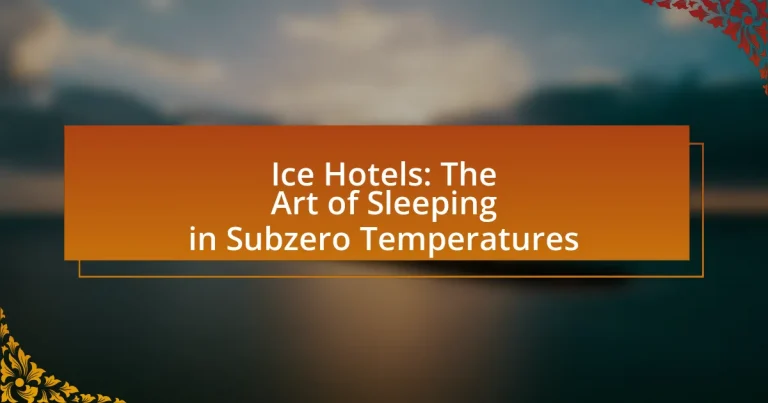Ice hotels are unique accommodations made entirely from ice and snow, offering guests an extraordinary experience in subzero temperatures. Constructed annually in cold climates such as Sweden and Canada, these hotels feature intricately designed rooms, ice sculptures, and various amenities. The article explores the construction process, materials used, and the challenges guests face while staying in these icy environments. It also highlights the unique features and activities available, the environmental impacts of ice hotels, and the innovations shaping their future. Additionally, practical tips for travelers considering a stay in an ice hotel are provided, ensuring a comfortable and memorable experience.

What are Ice Hotels?
Ice hotels are unique accommodations constructed entirely from ice and snow, offering guests a distinctive experience in subzero temperatures. These hotels are typically built annually in cold climates, such as Sweden and Canada, and feature intricately designed rooms, ice sculptures, and communal areas. The concept of ice hotels began with the establishment of the Icehotel in Jukkasjärvi, Sweden, in 1989, which has since become a popular tourist destination, attracting visitors who seek the novelty of sleeping on ice beds surrounded by artistic ice creations.
How are Ice Hotels constructed?
Ice hotels are constructed using large blocks of ice and snow, typically sourced from nearby rivers or lakes. The construction process begins with the harvesting of ice blocks, which are then shaped and assembled to form the structure of the hotel. Builders often use a combination of traditional techniques and modern tools, such as chainsaws and chisels, to create intricate designs and rooms. The walls, ceilings, and furniture are all made from ice, and the entire structure is reinforced with snow to ensure stability. The construction usually takes place during the winter months when temperatures are consistently below freezing, allowing the ice to remain solid and the hotel to be operational for guests.
What materials are used in the building of Ice Hotels?
Ice Hotels are primarily constructed using ice blocks harvested from nearby frozen lakes or rivers, along with snow. The ice serves as the main structural material, providing the necessary strength and insulation for the hotel. Snow is often used as a filler and insulator, enhancing the thermal properties of the structure. The combination of these materials allows Ice Hotels to maintain their integrity and provide a unique experience in subzero temperatures.
How long does it take to build an Ice Hotel?
Building an Ice Hotel typically takes about two to three months. This timeframe allows for the construction of the structure, which involves harvesting ice blocks, assembling them, and creating intricate designs. For instance, the famous Icehotel in Sweden is constructed annually, starting in November and completed by mid-January, showcasing the seasonal nature of such projects.
Where are the most famous Ice Hotels located?
The most famous Ice Hotels are located in Sweden, Norway, and Canada. The Icehotel in Jukkasjärvi, Sweden, is the world’s first and largest ice hotel, constructed annually from ice and snow. In Norway, the Sorrisniva Igloo Hotel in Alta is renowned for its unique design and artistic ice sculptures. Additionally, the Hôtel de Glace in Quebec, Canada, is notable for being the only ice hotel in North America, featuring intricate ice architecture and themed suites.
What unique features do these Ice Hotels offer?
Ice Hotels offer unique features such as intricately carved ice sculptures, themed suites, and subzero temperature accommodations that create a distinctive experience. These hotels are constructed entirely from ice and snow, with each season bringing new artistic designs and layouts, showcasing the craftsmanship of ice artists. Additionally, guests can enjoy amenities like ice bars, ice lounges, and outdoor activities such as snowmobiling and dog sledding, enhancing the overall experience of staying in a frozen environment.
How do geographical locations influence Ice Hotel design?
Geographical locations significantly influence Ice Hotel design by dictating the materials used, architectural styles, and overall structural integrity. For instance, in regions like Sweden and Canada, where temperatures consistently drop below freezing, designers utilize local ice and snow as primary building materials, ensuring that the hotels can withstand harsh winter conditions. Additionally, the design often reflects cultural elements specific to the area, such as motifs from indigenous art in Canada or Scandinavian aesthetics in Sweden. The availability of natural resources, such as the quality of ice and snow, also affects the construction techniques employed, leading to unique designs that are tailored to the specific environmental conditions of each location.
Why do people choose to stay in Ice Hotels?
People choose to stay in Ice Hotels for the unique experience they offer. These hotels provide an extraordinary opportunity to sleep in a structure made entirely of ice and snow, which is a novelty that attracts adventure seekers and those looking for a memorable getaway. The allure of staying in an environment that is artistically designed with intricate ice sculptures and themed rooms enhances the appeal. Additionally, Ice Hotels often feature amenities such as ice bars and gourmet dining, which further enrich the experience. The combination of adventure, artistry, and luxury in a subzero setting makes Ice Hotels a compelling choice for travelers seeking something out of the ordinary.
What experiences do guests seek in Ice Hotels?
Guests seek unique and immersive experiences in Ice Hotels, primarily focused on the novelty of staying in a structure made entirely of ice and snow. These experiences include enjoying intricately designed ice sculptures, participating in winter activities such as snowshoeing and ice fishing, and indulging in gourmet dining served in a stunning ice setting. Additionally, guests often look for opportunities to witness the Northern Lights, which are frequently visible in the regions where Ice Hotels are located. The allure of a once-in-a-lifetime adventure in a surreal environment drives the appeal of these accommodations, making them a popular choice for travelers seeking extraordinary experiences.
How do Ice Hotels cater to different types of travelers?
Ice Hotels cater to different types of travelers by offering a range of accommodations and experiences tailored to various preferences and budgets. For adventure seekers, Ice Hotels provide unique activities such as ice sculpting, snowshoeing, and dog sledding, enhancing the thrill of the subzero environment. For couples, romantic packages often include private ice suites and dining experiences under the stars, creating an intimate atmosphere. Families can enjoy family-friendly amenities, including guided tours and educational workshops about the ice construction process. Additionally, luxury travelers can indulge in premium services like spa treatments and gourmet dining, ensuring a high-end experience. This diverse offering allows Ice Hotels to attract and satisfy a wide array of guests, making them appealing to different demographics.

What is the experience of sleeping in subzero temperatures like?
Sleeping in subzero temperatures is an intense experience characterized by extreme cold that can lead to discomfort and potential health risks if not properly managed. The body struggles to maintain its core temperature, which can result in shivering and difficulty falling asleep. Proper insulation, such as thermal sleeping bags and layered clothing, is essential to mitigate these effects. Research indicates that individuals can adapt to cold sleeping environments over time, but initial experiences often involve a significant adjustment period. For instance, studies show that people sleeping in temperatures below freezing can experience disrupted sleep patterns due to the cold, highlighting the importance of adequate preparation and equipment for a safe and comfortable night.
How do Ice Hotels maintain comfortable sleeping conditions?
Ice Hotels maintain comfortable sleeping conditions by using thermal insulation techniques and specialized bedding. The walls of Ice Hotels are constructed from compacted snow and ice, which naturally insulate against the cold. Additionally, guests are provided with high-quality sleeping bags rated for extreme temperatures, which trap body heat and provide warmth. The combination of these factors ensures that despite the subzero environment, guests can sleep comfortably. Studies have shown that proper insulation and appropriate bedding can significantly enhance thermal comfort in cold environments, validating the effectiveness of these methods in Ice Hotels.
What bedding options are provided in Ice Hotels?
Ice Hotels provide bedding options that typically include thermal sleeping bags and insulated mattresses. These sleeping bags are designed to retain body heat in subzero temperatures, ensuring guest comfort. The mattresses are often made from materials that provide insulation against the cold ice structure, enhancing the overall sleeping experience in these unique accommodations.
How do guests stay warm during their stay?
Guests stay warm during their stay in ice hotels by utilizing thermal sleeping bags and insulated bedding. These specialized sleeping bags are designed to retain body heat, ensuring comfort in subzero temperatures. Additionally, the ice hotel structures are built with thick walls of ice that provide insulation, while the use of fur blankets and mattresses made from natural materials further enhances warmth. The combination of these elements creates a microclimate that helps guests maintain a comfortable temperature throughout the night.
What activities are available at Ice Hotels?
Ice Hotels offer a variety of activities including ice sculpting workshops, guided snowshoeing tours, and northern lights viewing. Guests can participate in creating their own ice sculptures, which enhances their artistic skills while enjoying the unique environment. Guided snowshoeing tours allow visitors to explore the surrounding winter landscapes, providing an immersive experience in nature. Additionally, many Ice Hotels provide opportunities for guests to witness the northern lights, a spectacular natural phenomenon that attracts many travelers to these locations.
How do Ice Hotels incorporate local culture into guest experiences?
Ice Hotels incorporate local culture into guest experiences by featuring art, architecture, and culinary traditions that reflect the surrounding community. For instance, many Ice Hotels collaborate with local artisans to create ice sculptures and themed rooms that showcase indigenous designs and folklore. Additionally, they often offer traditional meals prepared with local ingredients, allowing guests to taste regional flavors. This integration of local culture not only enhances the aesthetic appeal of the hotels but also provides guests with an immersive experience that connects them to the area’s heritage and traditions.
What seasonal events are hosted at Ice Hotels?
Ice Hotels host a variety of seasonal events, including winter festivals, ice sculpture competitions, and themed holiday celebrations. These events attract visitors looking to experience unique winter activities in a stunning icy environment. For example, the Ice Hotel in Sweden features an annual Ice Music Festival, where musicians perform using instruments made entirely of ice, showcasing the hotel’s commitment to creativity and artistry in a frozen setting.
What challenges do guests face when staying in Ice Hotels?
Guests face several challenges when staying in Ice Hotels, primarily related to extreme cold and unique accommodations. The subzero temperatures can lead to discomfort, as guests must adapt to sleeping in ice-carved rooms that lack traditional heating. Additionally, guests may struggle with limited amenities, such as shared bathrooms and the absence of electrical outlets for charging devices. The novelty of the experience can also lead to anxiety for some, as the unfamiliar environment may be daunting. Furthermore, guests must be mindful of their clothing choices, as inadequate attire can result in hypothermia or frostbite. These challenges highlight the need for preparation and awareness when choosing to stay in such unique accommodations.
How do guests prepare for their stay in an Ice Hotel?
Guests prepare for their stay in an Ice Hotel by packing appropriate cold-weather clothing and gear. This includes thermal layers, insulated jackets, hats, gloves, and waterproof boots to ensure warmth and comfort in subzero temperatures. Additionally, guests often bring sleeping bags rated for extreme cold, as some Ice Hotels provide these for added insulation. It is also advisable for guests to familiarize themselves with the hotel’s specific guidelines and recommendations, which may include tips on how to acclimate to the cold environment and what amenities are available.
What safety measures are in place for guests in Ice Hotels?
Ice Hotels implement several safety measures to ensure the well-being of their guests. These measures include temperature monitoring systems that maintain a consistent and safe environment, as well as emergency heating systems that activate in case of extreme cold. Additionally, staff are trained in safety protocols and first aid, and guests receive guidance on how to dress appropriately for the cold. Ice Hotels also provide insulated sleeping bags and thermal mattresses to enhance guest comfort and safety during their stay. These precautions are essential for maintaining a safe experience in subzero temperatures.

What are the environmental impacts of Ice Hotels?
Ice hotels have several environmental impacts, primarily related to energy consumption and resource use. The construction of ice hotels often requires significant energy for refrigeration to maintain the structure, which can lead to increased carbon emissions if non-renewable energy sources are used. Additionally, the sourcing of ice and snow can disrupt local ecosystems, particularly if natural ice formations are harvested unsustainably.
Research indicates that while some ice hotels aim for sustainability by using renewable energy and local materials, the overall environmental footprint can still be considerable. For instance, a study published in the Journal of Sustainable Tourism highlights that the energy-intensive nature of maintaining ice hotels can offset their potential benefits as unique tourist attractions.
How do Ice Hotels affect local ecosystems?
Ice hotels can disrupt local ecosystems primarily through their construction and operation, which often require significant energy and resources. The building process typically involves the use of large amounts of water from nearby sources, which can alter local hydrology and affect aquatic habitats. Additionally, the energy needed for refrigeration and lighting can lead to increased carbon emissions if sourced from fossil fuels, contributing to climate change that impacts local flora and fauna. Studies have shown that the presence of tourists can also lead to habitat degradation, as increased foot traffic and waste can harm sensitive environments. For instance, a report by the Arctic Council highlights that tourism-related activities can disturb wildlife and lead to changes in animal behavior.
What sustainable practices are implemented in Ice Hotel operations?
Ice Hotels implement several sustainable practices, including the use of locally sourced materials, energy-efficient lighting, and water conservation techniques. These hotels are constructed primarily from ice and snow, which are abundant in their environments, minimizing the carbon footprint associated with transportation. Additionally, they often utilize renewable energy sources, such as solar power, to reduce reliance on fossil fuels. Water conservation is achieved through the recycling of water used in the ice-making process, ensuring minimal waste. These practices not only enhance the ecological sustainability of Ice Hotels but also promote awareness of environmental issues among guests.
How do Ice Hotels contribute to climate awareness?
Ice Hotels contribute to climate awareness by showcasing the effects of climate change through their ephemeral nature. These hotels, constructed from ice and snow, highlight the fragility of winter ecosystems and the impact of rising temperatures on these environments. For instance, the Icehotel in Sweden has been built annually since 1989, and its existence is directly tied to the cold climate; as global temperatures rise, the viability of such structures diminishes. This direct correlation serves as a tangible reminder of climate change, prompting visitors to reflect on environmental issues and encouraging sustainable tourism practices.
What innovations are being introduced in Ice Hotel design?
Innovations in Ice Hotel design include the use of advanced thermal insulation materials, which enhance guest comfort while maintaining the unique ice structure. Additionally, architects are incorporating sustainable energy solutions, such as solar panels and geothermal heating, to reduce environmental impact. Recent designs also feature interactive ice sculptures and themed rooms that change annually, providing a fresh experience for returning guests. These innovations are supported by advancements in ice construction techniques, allowing for more intricate designs and improved structural integrity, as evidenced by the Icehotel in Sweden, which has been continuously evolving since its inception in 1989.
How is technology enhancing the Ice Hotel experience?
Technology enhances the Ice Hotel experience by integrating advanced climate control systems, which maintain optimal temperatures for guest comfort while preserving the ice structure. These systems utilize sensors and automated controls to monitor and adjust the environment, ensuring a stable and enjoyable stay. Additionally, augmented reality (AR) and virtual reality (VR) technologies are employed to create immersive experiences, allowing guests to explore the hotel and its surroundings in innovative ways. For instance, some Ice Hotels offer VR tours that showcase the artistry of ice sculptures and the design of the hotel, enriching the overall experience.
What future trends are expected in the Ice Hotel industry?
Future trends in the Ice Hotel industry include increased sustainability practices, technological integration, and enhanced guest experiences. As environmental concerns rise, ice hotels are expected to adopt eco-friendly materials and renewable energy sources, aligning with global sustainability goals. Additionally, advancements in technology will likely lead to smart room features, such as temperature control and personalized lighting, enhancing comfort for guests. Furthermore, unique thematic designs and immersive experiences, such as ice sculpting workshops and guided winter activities, are anticipated to attract a broader audience and create memorable stays. These trends reflect the industry’s adaptation to consumer preferences and environmental challenges.
What tips should travelers consider when booking an Ice Hotel stay?
Travelers should consider booking their Ice Hotel stay well in advance, as these unique accommodations often sell out quickly, especially during peak winter months. Ice Hotels typically have limited availability due to their seasonal nature and the intricate design process that requires time and skilled craftsmanship. Additionally, travelers should research the specific amenities offered, such as thermal sleeping bags or heated areas, to ensure comfort during their stay. Understanding the hotel’s location and accessibility is also crucial, as some Ice Hotels are remote and may require special transportation arrangements. Lastly, checking for package deals that include activities like ice sculpting or snowshoeing can enhance the overall experience, making the stay more memorable.
How can guests ensure a comfortable experience in an Ice Hotel?
Guests can ensure a comfortable experience in an Ice Hotel by dressing in layers and utilizing thermal sleeping bags provided by the hotel. Layered clothing traps heat and allows for temperature regulation, while high-quality thermal sleeping bags are designed to retain warmth in subzero conditions. Research indicates that proper insulation and thermal management are crucial for comfort in extreme cold environments, as evidenced by studies on hypothermia prevention and thermal comfort in cold climates.
What are the best times of year to visit Ice Hotels?
The best times of year to visit Ice Hotels are typically from December to March. During this period, temperatures are consistently low enough to maintain the structural integrity of the ice and snow used in construction. For example, many Ice Hotels, such as the Icehotel in Sweden, open in December and remain operational until April, with peak visitor numbers occurring during the winter months when the experience of subzero temperatures is most authentic and enjoyable.


